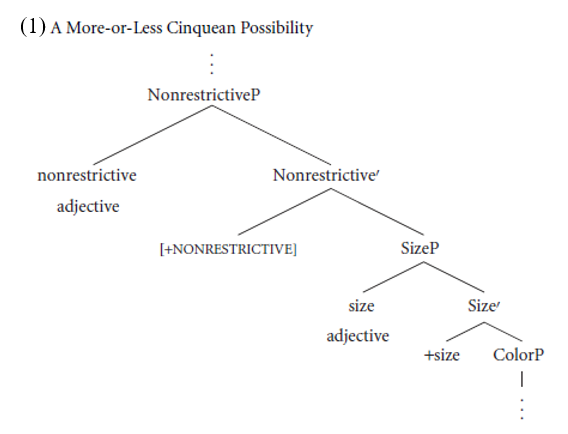


 Grammar
Grammar
 Tenses
Tenses
 Present
Present
 Past
Past
 Future
Future
 Parts Of Speech
Parts Of Speech
 Nouns
Nouns
 Verbs
Verbs
 Adverbs
Adverbs
 Adjectives
Adjectives
 Pronouns
Pronouns
 Pre Position
Pre Position
 Preposition by function
Preposition by function 
 Preposition by construction
Preposition by construction
 Conjunctions
Conjunctions
 Interjections
Interjections
 Grammar Rules
Grammar Rules
 Linguistics
Linguistics
 Semantics
Semantics
 Pragmatics
Pragmatics
 Reading Comprehension
Reading Comprehension| Some analytical possibilities- Assimilating these to other effects of modifier position |
|
|
|
Read More
Date: 28-2-2022
Date: 2024-01-11
Date: 2024-01-02
|
Some analytical possibilities- Assimilating these to other effects of modifier position
Another natural approach to these observations is to suppose that the solution should follow straightforwardly from a general theory of modifier position – from whatever determines the relative order of evaluation, color, and size adjectives, for example, or pragmatic, subject-oriented, and manner adverbs. This is in some respects appealing, but it is not clear what its content would be without committing to a particular theory of this sort.
General theories in this domain are hard to come by (ones that aspire to high degrees of empirical breadth include Ernst 2002; Cinque 1999; Alexiadou 1997; Morzycki 2005). The most familiar of these, and perhaps the only one in which an account of these facts would be available straightforwardly, is the framework of Cinque (1999), in which particular positions in a tree are idiosyncratically associated with particular modifier classes. Might there be, then, a single spot associated with nonrestrictive modification, understandable perhaps in a vaguely Cinquean (Cinque 1994, 1999, and many others) treatment as in (1)?

Perhaps. But there are reasons to think that these facts about nonrestrictive readings are of a different sort. One is that, as Shaer points out, the restrictive/nonrestrictive distinction in adverbs cuts across adverb classes. Both the subject-oriented adverb accidentally and the (pure) manner adverb softly manifest the contrast, for example:

This distinction similarly cross-cuts adjective classes as well. Another difficulty with such an approach is that the restrictive/ nonrestrictive contrast targets multiple modifiers at a time, grouping together members of different classes:
(3) I’m positively tickled pink to meet your charming Norwegian friend.
Here, all the prenominal adjectives are most naturally interpreted nonrestrictively – this does not suggest that the addressee has any other wives, or that any of them are anything other than charming, lovely, and Norwegian.1
1 Curiously, it seems to be the case that when one prenominal adjective is interpreted nonrestrictively, all of them tend to be. I have no explanation of this, apart from the speculation that it may be a psycholinguistic effect of some sort.
|
|
|
|
التوتر والسرطان.. علماء يحذرون من "صلة خطيرة"
|
|
|
|
|
|
|
مرآة السيارة: مدى دقة عكسها للصورة الصحيحة
|
|
|
|
|
|
|
نحو شراكة وطنية متكاملة.. الأمين العام للعتبة الحسينية يبحث مع وكيل وزارة الخارجية آفاق التعاون المؤسسي
|
|
|